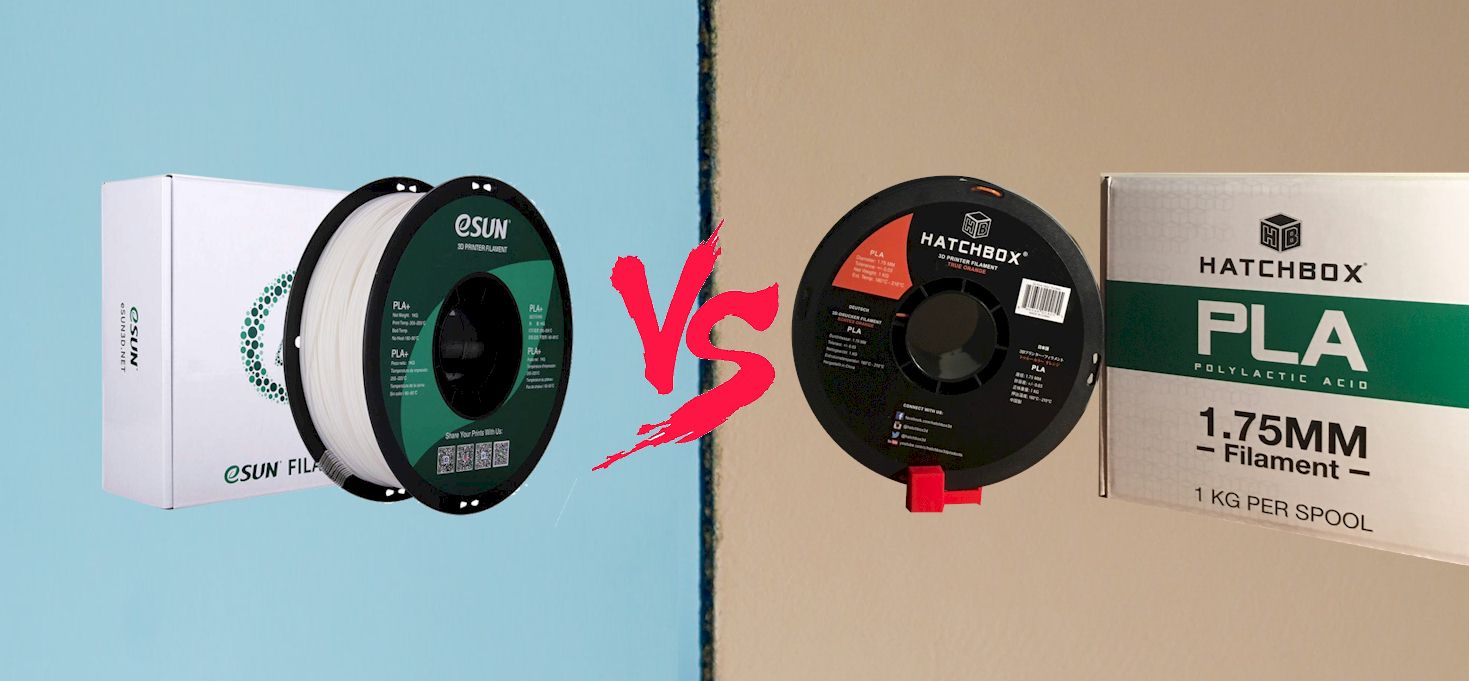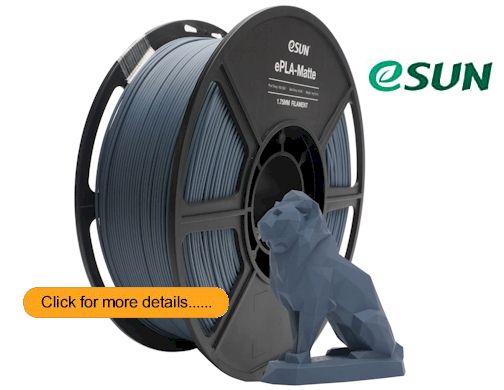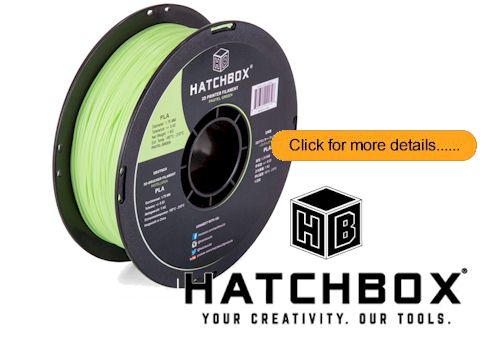Did you know that PLA filaments are the most popular components for 3D printers currently? These are super affordable, can tolerate even the highest temperatures, and deliver top-tier glossy finishes without much effort. It goes without saying that when such distinguished PLA brands are in question, we compare Esun vs Hatchbox.
Esun promises seamless research, development, sales, and production of the best 3D printing materials. Their in-depth development in the industry led to a boom of research from multiple backgrounds and product designs. On the other hand, Hatchbox, a USA-based filament brand, offers a wide array of ABS and PLA blends.
This is why it gets unbearably confusing to choose one amongst the two. Thus, this article will debunk everything about the two brands, their features, use, market value, and more! Let’s take a quick scan and know which one stands out.
Features Of Esun PLA 3D Printer Filament:
The Esun filament reviews distinguish themselves differently as 3D printing enthusiasts know their easy print accessibilities and unique layer bonding mechanism. These are also their USP in the market.
Esun commits to bonding ideally, making each PLA 3D print genuinely stand out among other contenders. Moreover, this brand has excellent durability with less to zero risks of breakage. It can work under 205C to 225C temperature and reasonably well with most best-selling 3D printers.
The hub hole in Esun has a diameter of 2.05″ and an inner hole of 3.5″. These settings are pretty universal and applicable to most commercial 3D printers. People love Esun because of its unmatchable reliability and strength in every feature.
But the best part is that you can acquire some of the best-looking glossy finishes on these at an incredibly low price point. For all your miniature work and printing needs, Esun deserves to be known.
Esun Filament Specifications:
- Spool Weight: 2.2 lbs
- Filament’s Diameter: 1.75mm
Pros Of Esun PLA 3D Printer Filaments:
Now that we understand that, like every other Esun PLA review, ours was glowing too, we must look into the specific pros and cons for the brand.
- This PLA is exceptionally durable.
- Esun has a wide range of uses and applications.
- It enables a smooth and glossy print that genuinely stands out in the crowd.
- The work remains fresh and neat for a prolonged time due to moisture-absorbent chemicals and vacuum packaging.
- Works well with mono dimensional, lightly heated hot ends.
- Provides consistent results in each piece.
Cons Of Esun PLA 3D Printer Filaments:
- The Esun brand’s filaments are not exactly the cheapest in the market.
Features Of Hatchbox PLA 3D Printer Filament:
Hatchbox is yet another well-renowned company famous for its unique and brilliant capacities all around the globe. This USA-based company offers high-quality PLA results and other performances which are extremely reasonably priced.
After reading this Hatchbox filament review, you will be sweetly surprised to know that the overall quality and cost are now at par compared to the other high-end filament brands in the market. There’s no wonder now why Hatchbox creates near-perfect and appealing outcomes with every use.
Moreover, Hatchbox is quite recognized for its PETG printing offerings too. They focus on bringing top-notch prints worth high value. If you’re looking for prints that last a long time, Hatchbox just might make the cut.
And as if that’s not enough, to boost the convenience of every type of user in the market, Hatchbox PLA 3D prints are also available on most online selling platforms.
Fortunately, the prices on these websites are equally consistent and affordable, with beaming reviews and star ratings. Hatchbox is the product users keep going back to for its seamless layering height techniques and offerings on wood.
However, the USP that makes Hatchbox superior to the rest is its reputation of bringing environmentally-friendly, biodegradable plastics in the construction that reduces the footprint on the planet by a mile.
Related: HIPS vs PVA
Hatchbox PLA 3D Printer Filaments Specifications:
- Spool Weight: 2.2 lbs
- Filament’s Diameter: 1.75mm / 3mm
Pros Of Hatchbox PLA 3D Printer Filaments:
What’s left now is to know a tad bit more about Hatchbox’s pros and cons as reviewing these will enhance your idea of the distinctions and preferred features.
- Hatchbox promotes and promises silky smooth finishes with lower CO2 footprints.
- This structure of this brand involves eco-friendly bioplastics.
- If your job requires hobbyist articles, cosplay articles, and miniatures prints, this is the one to rely on.
- Hatchbox construction has a remarkable blend of polymers.
Cons Of Hatchbox PLA 3D Printer Filaments:
- Affordable yet, not the lowest priced filament in the global market.
Esun VS Hatchbox – A Neck To Neck Comparison:
So far, we’ve discussed all the basics and characteristics of the Hatchbox and Esun filaments. And let’s face it, they’re both quite remarkable in their ways.
However, to get an even clearer picture, it’s wiser to look into the comparisons based on a few crucial factors. Let’s check what they are and end this war – hopefully.
Compatibility
What if you purchase a top-rated filament tool, but it turns out to be incompatible with your 3D printer? You guessed it – it would be an enormous waste of money and time.
Truth be told, even though some brands fail in this department, both of our subjects win in this regard. The filaments are available at 1.75mm, compatible with most 3D printers.
Uses
Lucky for us as starting from the Esun and Hatchbox filament websites to their features and primary handling – they’re all highly regarded for being easiest. Their easy-to-use and managing features quickly become a favorite for professionals, but it also allows newbies to shoot their shot.
Moreover, along with simple usage, both equally deliver high compatibility, quality, and consistent results. Whereas Hatchbox go-to filaments work wonders for intricate details on projects, Esun stands a better chance for practical work with high durability.
PLA
Esun has superior strength compared to generic PLA due to their PLA+ filaments. And unfortunately, Hatchbox doesn’t own such an advanced filament type.
Durability
With Hatchbox, you acquire eco-friendly, vacuum-packed, and moisture-absorbing creations. However, even though Esun doesn’t acclaim such eco-friendly features, their filaments are far more robust and superior in terms of strength.
This leads to many opting for Esun as their first choice as it can handle heavy-duty productions even if they’re fragile and doesn’t put the users at risk of encountering damages and breakage.
Finish
The look and appeal need consistent performance with silky smooth finished. Esun produces top-rates glossy and shiny finishes whereas, Hatchbox creates intricate matte finishes.
To put it in other words, it all depends on the kind of finish you’re opting to achieve. Honestly, they both look pretty appealing and fresh in their own ways.
Environmental Impact
If you’re aware of the environmental impacts that we all succumb to once now and then and you’re willing to promote the opposite, Hatchbox is the way to go.
It’s a no-brainer that producing 3D printing elements has environmental cons, and to beat that Hatchbox has intuitively thought of alternate paths. However, Esun is also gradually boasting its game by introducing biodegradable filaments that are environmentally sound and safe.
Many PLA filaments are utilized for medical and children products; thus, users must be cautious and make wise judgments.
Adding Paint
Let’s put it straight, Esun falls behind a little with their white filament’s quality. Even though it produces adequate colors and a broad spectrum of colors, you might have to add in multiple colors to find the perfect fit on numerous occasions.
However, a transparent or white filament is all you need to achieve it. Although both brands offer the same capacity, many professionals agree that Esun is a step ahead as it offers enhanced consistency.
Color Choices
Hatchbox happens to be the clear winner as they offer around 26 colors. Meanwhile, Esun only offers around 9 shades. Hatchbox filaments come with an extensive range of primary colors but, it doesn’t stop there.
The brand also hosts unique filament colors such as glow-in-the-dark, copper, bronze, and more to elevate their palette and bring a better competitive advantage.
Cost
Compared to nylon filaments, PLA has an extensively affordable range. Having said that, neither Hatchbox nor Esun are precisely the cheapest options in the market. Special PLA packages vary at hundreds of dollars, whereas the typical cost is $15-$30.
Hence, both of these ranges sit somewhere around the high-end category. However, many other brands charge a whopping $20 or even more. Esun’s polylactic acid filaments are a few bucks cheaper than others in the market, but the difference is quite negligible.
Wrap Up:
We’re at the end of this highly competitive, Esun vs Hatchbox review. To be very honest, both of these brands have high availability and popularity, and for good reasons. They can both tailor to an array of demands for 3D printing fanatics all around the globe.
Moreover, their durable, budget-friendly, and consistent output features have acquired incomprehensible raving critiques from professional and amateur users. Hatchbox and Esun are pretty head-to-head in this challenge; however, in the end, it all depends on the users’ specific requirements and needs.
3D printing practitioners must have a clear picture of how they need their prints to come out. Only then can they purchase one of these to complement their essentials.
Contents


